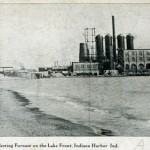Once lauded as the world’s most progressive dwellings, five vintage model homes have long since nestled into the dunes of Indiana’s Lake Michigan shoreline.
Unveiled at the 1933 Chicago World’s Fair–whose theme was “A Century of Progress” –the prototypes eventually made their way to the fledgling resort town of Beverly Shores.
Designed by leading architects of the era, the homes range stylistically from a rustic cypress lodge to a modernist fantasy in pink stucco. The houses were built to showcase innovative technologies and materials, and anticipated major shifts in lifestyle.
The Armco-Ferro House, for example, featured a dishwasher and central air conditioning and was constructed of corrugated steel panels faced with enameled porcelain. The so-called House of Tomorrow had a hangar for an airplane, assumed to be an everyday amenity for families of the future.
When the World’s Fair closed in 1936, the homes were purchased by private investors, one of whom was developing a resort town in the Indiana dunes. After the Chicago, South Shore and South Bend Railroad started increasing traffic to the Lake Michigan shoreline in the late 1920s, real estate developer Frederick Bartlett purchased 3600 acres to plot into home sites.
Although the Great Depression intervened, in the mid-1930s Bartlett’s brother Robert took over the project, naming the resort after his daughter. In addition to building houses, hotels and infrastructure, Bartlett purchased the Century of Progress homes and had them reconstructed in Beverly Shores as a tourist attraction.
In addition to the five futuristic homes, Bartlett purchased other World’s Fair models that were replicas of colonial sites—from Mount Vernon to Paul Revere’s home.
Four of the sixteen World’s Fair structures Bartlett acquired were transported by barge across Lake Michigan, requiring that a channel be dredged to allow docking.
Only six of the sixteen buildings survived the twentieth century; in the meantime the Homes of Tomorrow became increasingly derelict. The artificial stone used in the walls of the Wieboldt-Rostone house was crumbling by the 1950s; the ceramic-tiled roof of the Florida Tropical House couldn’t withstand the Midwestern winter; and the cutting-edge cooling system failed to dispatch the heat in the model with glass walls.
In the 1990s the National Park Service initiated a public-private partnership to restore the homes, extending 30-year subleases to tenants willing to undertake the restoration of Beverly Shores’ modernist souvenirs.
Recognized by the National Register of Historic Places, the Century of Progress Architectural District comprises 208, 210, 212, 214 and 215 Lake Front Drive in Beverly Shores, Indiana. The homes are open to the public one weekend each year.






















